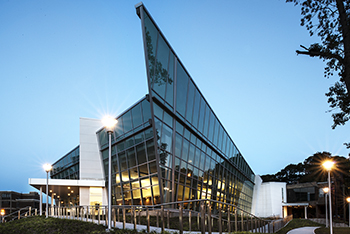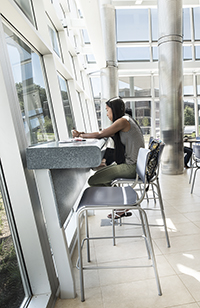Stony Brook Debuts 21st Century Dining Hall
 STONY BROOK, N.Y. — The new West Side Dining Hall at Stony Brook University in New York caters to 21st century students not only because of its sustainable design, but also because of its diverse dining options available to the wide range of students that attend the school.
STONY BROOK, N.Y. — The new West Side Dining Hall at Stony Brook University in New York caters to 21st century students not only because of its sustainable design, but also because of its diverse dining options available to the wide range of students that attend the school.
The 40,000-square-foot addition and renovation to the existing, 1960s-era Kelly Dining Hall opened in time for the 2013 school year. It provides more than 400 inside and outside seating options and offers a variety of dining platforms. Digital displays present the six menu choices that range from Eastern Cuisine to Bob’s BBQ.
“The biggest criteria that’s so wonderful about Stony Brook is the diversity — different culinary expectations and needs,” said Armand Quadrini, principal at New York-based KSQ Architects, the architect on the project. “Kosher, halal and in between elements are addressed in this dining center.”
The dining hall’s six dining “platforms,” as Juana Gomez, project architect for KSQ, described them, each offer a display-cooking aspect that allows students to connect visually with the food preparation areas, giving them an understanding of the quality of food they’re eating. At each platform, a patron can also purchase an entire meal — quite different than the food court set-up that the previous dining hall had.
“This building is not only a beautiful architectural jewel, it has changed the way the students can see how to eat on campus dining,” Gomez said. “It’s not cafeteria-style dining. Each platform is functioning as a mini restaurant and is served like it was cooked for you.”
The university was in need of a modernized ground level dining center that met their needs in terms of a diverse menu and ease of service, Quadrini said. As such, the building features a contemporary design. He described it as a “very glassy lantern that invites community and activity and people into the structure.”
 The previous building had a Brutalist character, so KSQ developed a modern glass “shard” steel and curtain wall envelope. The design team brought the shard right out into the street for what Quadrini called, “a more urban approach,” unlike the other buildings on campus that are situated within the landscape. This gives students more of a connection the environment and the pedestrian culture of the road. Another key design element included a garden wall, which visually blocks the loading dock access from the road.
The previous building had a Brutalist character, so KSQ developed a modern glass “shard” steel and curtain wall envelope. The design team brought the shard right out into the street for what Quadrini called, “a more urban approach,” unlike the other buildings on campus that are situated within the landscape. This gives students more of a connection the environment and the pedestrian culture of the road. Another key design element included a garden wall, which visually blocks the loading dock access from the road.
Designed to achieve LEED Silver certification, the building features a white bitumen asphalt roof, glass frit and low-e coating on the curtain wall to decrease sun exposure, waterless urinals and an automated vent hood system throughout the kitchen. The project team also used recycled materials, diverted construction waste and created water-efficient landscaping.
One of the major challenges on the project was phasing the project to keep the existing dining hall open during construction and completing the new dining hall before closing the existing one for renovations. The fact that site was also sandwiched between a number of student housing facilities also posed a challenge, especially since the design team wanted to keep all of the landscape surrounding the building.
In October, the project received honor awards from two New York state chapters. It was awarded an Excellence in Architecture Award by the Long Island AIA chapter, and also received an Honor Award from the Westchester Hudson Valley AIA chapter.
